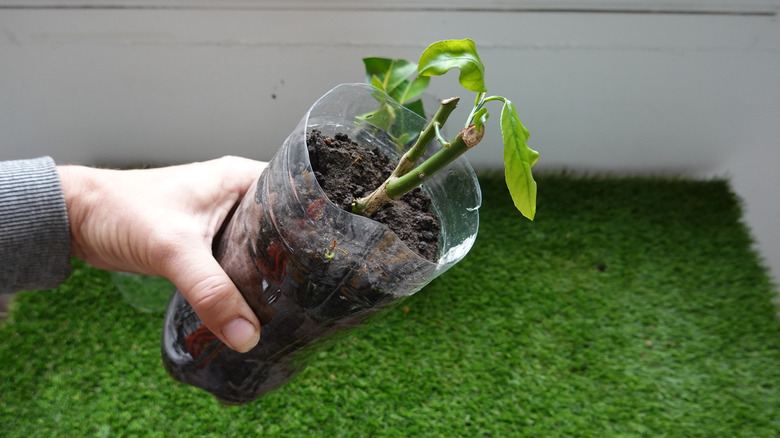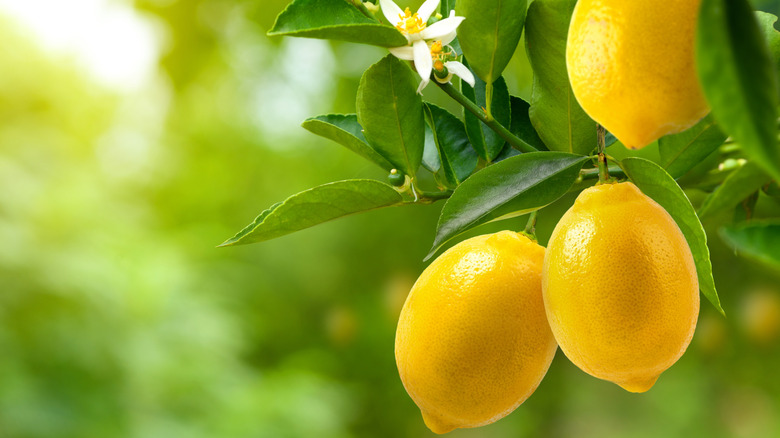Is This Potato Trick A Genius Way To Propagate Woody Plants With Little Effort?
For the uninitiated, sometimes gardening looks less like a genteel or earthy botanical pursuit and more like alchemy or the sort of thing you might learn in a herbology class at Hogwarts. Case in point: This TikTok video, which covers a potato hack to air layer a lemon tree. In it, @green.life049 strips the bark away from a lemon tree branch, wraps a peeled potato around it, and submerges the tuber in a cup of soil. The tree formed new roots where the bark was removed, and you can separate that part of the tree and plant it as a clone. In this case, the potato also sprouted and grew, giving new meaning to companion planting for potatoes.
It's hard to tell if this is an attempt to demystify the air layering process of propagating woody plants, or mystifying it. The video is part of a series on air layering by @green.life049, variously making use of potatoes, bananas, and tomatoes to facilitate the air layering process. And another video shows the traditional, soil-only air procedure. To get a sense of what exactly is going on here, we spoke exclusively with Tiffany Selvey, House Digest's garden editor and in-house master gardener, about air layering and what a potato might — or might not — bring to the party. "Air layering is a common practice for propagating woody plants, like the lemon tree shown in this video, roses, blackberries, and many more," Selvey explained. "Generally, the process involves using a moist medium like peat mixed with soil or something similar." Indeed, HGTV has promoted air layering for propagating blackberries.
Why not use a potato for air layering?
One of the unexpected minor benefits of using a potato as an element in air layering is that you might get a potato plant in the bargain, as @green.life049 does. But in terms of propagating the lemon tree, it's not clear what the potato accomplishes. Indeed, House Digest master gardener Tiffany Selvey seemed dubious when we spoke with her exclusively about it. "I have seen people try to root roses in potatoes with mixed results, but I've never seen one used in air layering," she said. "Frankly, I'm not sure there's much, if any, benefit to it." Notably, the video doesn't make a case that using a potato somehow improves on the usual, tried-and-true air layering process. "I suspect the potential benefits may be the accessibility of nutrients from the potato as it decomposes and consistent moisture, but with proper air layering, these issues are already addressed," Selvey said.
Air-layering is best accomplished with a medium that is less likely to break down dramatically and harbors fewer pathogens in the long run — a bit more friendly to a vulnerable plant you just stripped bark from. "My concern with this process would be rotting," Selvey explained. "As the potato decomposes and the cup holds water, it would create the perfect environment for bacteria to grow. This could infect the exposed tissue of the tree branch and cause it to rot instead of root. In the worst case scenario, it could potentially ruin a young tree."
How to accomplish the same thing with traditional air layering
So how would you go about cloning a fruit tree or another woody plant without involving potatoes ... or bananas or tomatoes, for that matter? It turns out to be a fairly mystery-free and somewhat familiar process when you leave off the produce section. "Air layering mimics the process of tip layering — the practice of burying the tip of a plant so it roots and produces a new plant — but on a branch," master gardener Tiffany Selvey explained in her exclusive talk with House Digest.
Typically, you'd choose a young branch on a healthy donor tree that's around ½ inch in diameter. This branch will become your cloned tree. Remove a 1-inch section of bark all the way around the branch, exposing its inner tissue. Around this new root zone, add a moist ball of something like half peat moss and half high-quality soil or soilless potting mix. To keep this together and moist, cover it with cling wrap and tie (or use a cable tie) to secure this rooting medium to the branch. You can also use a food storage bag or aluminum foil to air layer garden plants. Take care not to attach it too tightly.
"Next, just let nature do its job," Selvey said. "Check your branch frequently, and when you have several visible roots that are an inch or so long, cut the branch just below the root section and plant it."

